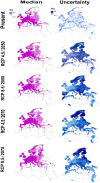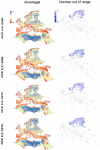Climate change influences on the potential geographic distribution of the disease vector tick Ixodes ricinus
- PMID: 29206879
- PMCID: PMC5716528
- DOI: 10.1371/journal.pone.0189092
Climate change influences on the potential geographic distribution of the disease vector tick Ixodes ricinus
Abstract
Background: Ixodes ricinus is a species of hard tick that transmits several important diseases in Europe and North Africa, including Lyme borreliosis and tick-borne encephalitis. Climate change is affecting the geographic distributions and abundances of arthropod vectors, which in turn influence the geographic distribution and epidemiology of associated vector-borne diseases. To date, few studies have investigated effects of climate change on the spatial distribution of I. ricinus at continental extents. Here, we assessed the potential distribution of I. ricinus under current and future climate conditions to understand how climate change will influence the geographic distribution of this important tick vector in coming decades.
Method: We used ecological niche modeling to estimate the geographic distribution of I. ricinus with respect to current climate, and then assessed its future potential distribution under different climate change scenarios. This approach integrates occurrence records of I. ricinus with six relevant environmental variables over a continental extent that includes Europe, North Africa, and the Middle East. Future projections were based on climate data from 17 general circulation models (GCMs) under 2 representative concentration pathway emissions scenarios (RCPs), for the years 2050 and 2070.
Result: The present and future potential distributions of I. ricinus showed broad overlap across most of western and central Europe, and in more narrow zones in eastern and northern Europe, and North Africa. Potential expansions were observed in northern and eastern Europe. These results indicate that I. ricinus populations could emerge in areas in which they are currently lacking, posing increased risks to human health in those areas. However, the future of I. ricinus ticks in some important regions such the Mediterranean was unclear owing to high uncertainty in model predictions.
Conflict of interest statement
Figures




References
-
- Parola P, Raoult D. Tick-borne bacterial diseases emerging in Europe. Clinical Microbiology and Infection. 2001;7(2):80–3. - PubMed
-
- Estrada-Peña A, de la Fuente J. The ecology of ticks and epidemiology of tick-borne viral diseases. Antiviral Research. 2014;108:104–28. doi: 10.1016/j.antiviral.2014.05.016 - DOI - PubMed
-
- Diuk-Wasser MA, Hoen AG, Cislo P, Brinkerhoff R, Hamer SA, Rowland M, et al. Human risk of infection with Borrelia burgdorferi, the Lyme disease agent, in eastern United States. The American journal of Tropical Medicine and Hygiene. 2012;86(2):320–7. doi: 10.4269/ajtmh.2012.11-0395 - DOI - PMC - PubMed
-
- Derdáková M, Lencakova D. Association of genetic variability within the Borrelia burgdorferi sensu lato with the ecology, epidemiology of Lyme borreliosis in Europe. Annals of Agricultural and Environmental Medicine. 2005;12(2):165 - PubMed
-
- Hayasaka D, Ivanov L, Leonova GN, Goto A, Yoshii K, Mizutani T, et al. Distribution and characterization of tick-borne encephalitis viruses from Siberia and far-eastern Asia. Journal of General Virology. 2001;82(6):1319–28. - PubMed
MeSH terms
LinkOut - more resources
Full Text Sources
Other Literature Sources
Medical

